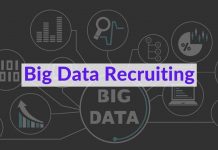Talent Intelligence or TI is a buzzword that has been used quite often in the recruitment industry for the past few years. So what is Talent Intelligence, and how does it add value to the organization when we hire some new talent, will be explained in this article.
 Talent intelligence can be defined as the process used by a company to collect and analyze external data regarding their competitors’ talent pool, skills, jobs, and functions and then using this data to gain a competitive edge.
Talent intelligence can be defined as the process used by a company to collect and analyze external data regarding their competitors’ talent pool, skills, jobs, and functions and then using this data to gain a competitive edge.
What is Talent Intelligence?
Talent Intelligence is not about data that recruiters gather about the prospective candidates. Talent Intelligence is all about what are the core areas of the recruitment process that can be assigned to technology and how best to utilize that data.
When your organization adapts Talent Intelligence, it will rely on Customer Relationship Management tools (CRM) to identify their recruitment patterns, trends and track candidates. When the recruiters need to source candidates, they can utilize AI candidate sourcing automation technology, which helps them find the right candidate quickly.
In other words. Talent Intelligence is all about refocusing time and energy spent by recruiters on tasks that AI technology can handle and shifting that energy to perform crucial tasks of the recruitment process, such as interviewing candidates, meeting with clients, and improving the candidate experience and planning long term strategy development.
How to Implement Talent Intelligence?
The first step to implement Talent Intelligence in an organization is by gathering the data. The recruitment teams can perform the data collection, which can be done by:
- Candidate pool in the CRM
- Internal employees
- Ex-employees
- Passive candidates
- Competitors
The next step of the process is to understand how best the data can be utilized. The data collected is to be analyzed and articulated into comprehensive reports to provide key insights on:
- Which candidates are interested in working with our Company?
- Who will be the ideal candidate for different teams?
- Who is keen to work in this industry, and how best they deliver the results?
- Potential candidate employment history
- Skillset the candidate posses
- Education
- Salary
- Social Media History
Why Should a business use Talent Intelligence?
An organization can implement Talent Intelligence to analyze some of the vital recruitment metrics such as :
1. Source and Quality of Hire:
One of the biggest challenges for any recruiter is the sourcing of candidates and the quality of hire. Gathering data and analyzing it will be crucial to understand these metrics in detail. The recruiters might encounter few challenges, such as a job board attracting many applicants may not be the same as the job board or a sourcing channel providing the highest number of quality hires but only a few applicants.
For instance, for a company, the number of job applicants it received for a job portal X might be higher than any other job portals. But the hiring success rate is not for the job portal X, but it is coming from the social media website such as LinkedIn. To gather such data, implementing Talent Intelligence is necessary, and based on data, management can decide where they invest the money to source candidates.
According to LinkedIn, 40% of companies’ worldviews rank the quality of hire as their top priority.
2. Talent Acquisition Cost:
If not the most preferred metric, cost per hire is one of the key recruitment metrics for many organizations across the world. Recruiters are spending hours and using the Company’s resources to acquire new candidates, and the overall cost to acquire a candidate will impact companies’ bottom line.
According to SHRM, the average cost to acquire a candidate is $ 4,129, and Talent Intelligence can significantly reduce this cost by improving each recruiting cycle stage.
For example, A company can use Talent Intelligence to understand the bottlenecks in their talent acquisition process. If data suggest that recruiters are spending more time sourcing candidates, which is done manually, the software can be automated.
3. Employee Turnover:
Employee turnover refers to the number or percentage of workers who leave an organization and are replaced by new employees. Replacing an employee is a tedious task that requires much effort from the recruitment team to find a similar candidate with the same skill set. Replacing an employee can cost around 30-40% of their annual salary. And the higher the hierarchy, the higher the cost gets.
Cost can be cut down cost only by retaining more and more employees. Using Talent Intelligence, HR teams can understand where the problem lies and what strategies they need to use to retain more employees. The starting point can be set of the questions listed below:
- What is the employee turnover rate?
- What is the average tenure of the employee?
- Which department is having the highest turnover rate?
- Is yearly targets one of the significant reasons for an employee leaving the organization?
- What is the most common reason for an employee to quit their job?
- What is the average employee stratification score?
The Rise of Talent Intelligence:
People Intelligence is one the most required aspects for any organization. According to a study done by Delloite, 3 out of 4 companies (71%) companies believe people analytics is an urgent priority. This year, it is a must-have tool for the HR teams due to the disruption caused by the COVID-19 pandemic.
The COVID-19 pandemic had changed the way we work. HR teams are no longer interacting with candidates directly and interact with the hiring manager through Skype or Zoom to understand the new requirement. Data is more needed than ever, and the HR teams regularly use data to analyze the hiring patterns or predict when the next employee leaves the organization.
The current adoption level isn’t surprising, as analytics is increasingly being used to address business problems including, recruiting, performance measurement, compensation, workforce planning, and retention. The current HR professionals are no longer only hooked at searching candidate resumes and speaking to prospective clients but also engaged in leveraging analytics as part of their general HR role and mainly focusing on HR analytics. The HR teams involved in these teams are known as “talent analytics” and “people analytics” teams.
Talent Intelligence Trends for Future:
The pandemic had changed the way teams will use data, and it is expected that companies will increase the adoption of talent analytics. With the phenomenal rise in talent intelligence, it is rare to come across an organization that hasn’t implemented analytics for its HR team. Below are three significant trends that will shape Talent Intelligence in the future.
1. HR Upskilling:
Upskilling of HR professionals would have never in the mind of the management a decade ago. But with the rapid rise of usage of analytics and development of both in-house data intelligence platforms and external vendors platforms, the need of the hour is to upskill the HR and Talent acquisition teams on how to access, manipulate and interpret the data on these tools.
2. Liaison with Management:
Before adopting talent analytics in organizations, HR teams used to interact seldom with the management. The majority of times, it used to be a discussion on hiring C-Level executives and top executives. However, with the implementation of talent analytics, the HR team needs to work closely and build a partnership with management and corporate strategy teams to develop a strategy for using the data and what information must be reported.
3. Automation:
HR teams must understand the things that need to be automated in the recruitment process are. In the future, there will be more unstructured data that needs to be analyzed. However, all the data is not helpful for the HR teams, and some of the data processing can be automated. Results can be directly generated in a standard report format.
Leveraging Talent Intelligence for Strategic Decision Making:
How come the organizations use Talent Intelligence to their advantage and improve the recruitment process is one of the critical aspects leadership looks at while implementing Data-Driven Software. Moreover, organizations require real-time, actionable, and on-demand insights vital to any decision while hiring a candidate.
Apart from hiring the candidate, Talent Intelligence can be used to make larger business decision making such as:
- Talent Intelligence can predict when the subsequent hiring will happen and how much the headcount will increase at a particular location or office. Based on such data, an organization can plan with the real estate teams to discuss the space required to accompany new hires.
- Working on a competitor hiring analysis to understand the competitor’s potential pivots. This will allow organizations to analyze how different businesses might work in new ways in the future and how they compete for head to head.
- As the COVID-19 pandemic had affected almost every business in the world, as we advance into a new era, Talent Intelligence can offer various insights on workforce transformation, which geographical region will new spots for the business expand, what are the skillset required in the future, How many employees can work remotely and how many needed to work from the office and so on.
- COVID-19 Panemdic had allowed more prominent organizations to acquire smaller firms that we’re unable to cope with the epidemic. Organizations can rely on Talent Intelligence tools to understand the talent, skillset of potential acquihire targets, and how they can fill the gap in their organizations.
Conclusion:
In recent years, Talent Intelligence has evolved from a mere data collection tool to analyze every aspect of recruitment and predicting how organizations need to pivot themselves in the future. However, Talent Intelligence is an emerging field. Still, the COVID-19 pandemic had accelerated the usage of data-driven software. In the post-COVID-19 world, organizations will not limit data-driven software usage but will further invest in gathering more meaningful data as it provides them with a competitive advantage.
For organizations to thrive and reach their goals, they need to have the right skilled people, and this is where Talent Intelligence adds value. Applying external data related to people, skills, jobs, functions, location, and competitors will drive the business decisions.
However, to get the right data, organizations need to employ skilled people in the HR teams. This can also be done by upskilling HR team members and making them experts in handling the data and extracting the information required that adds value to the organization.









































